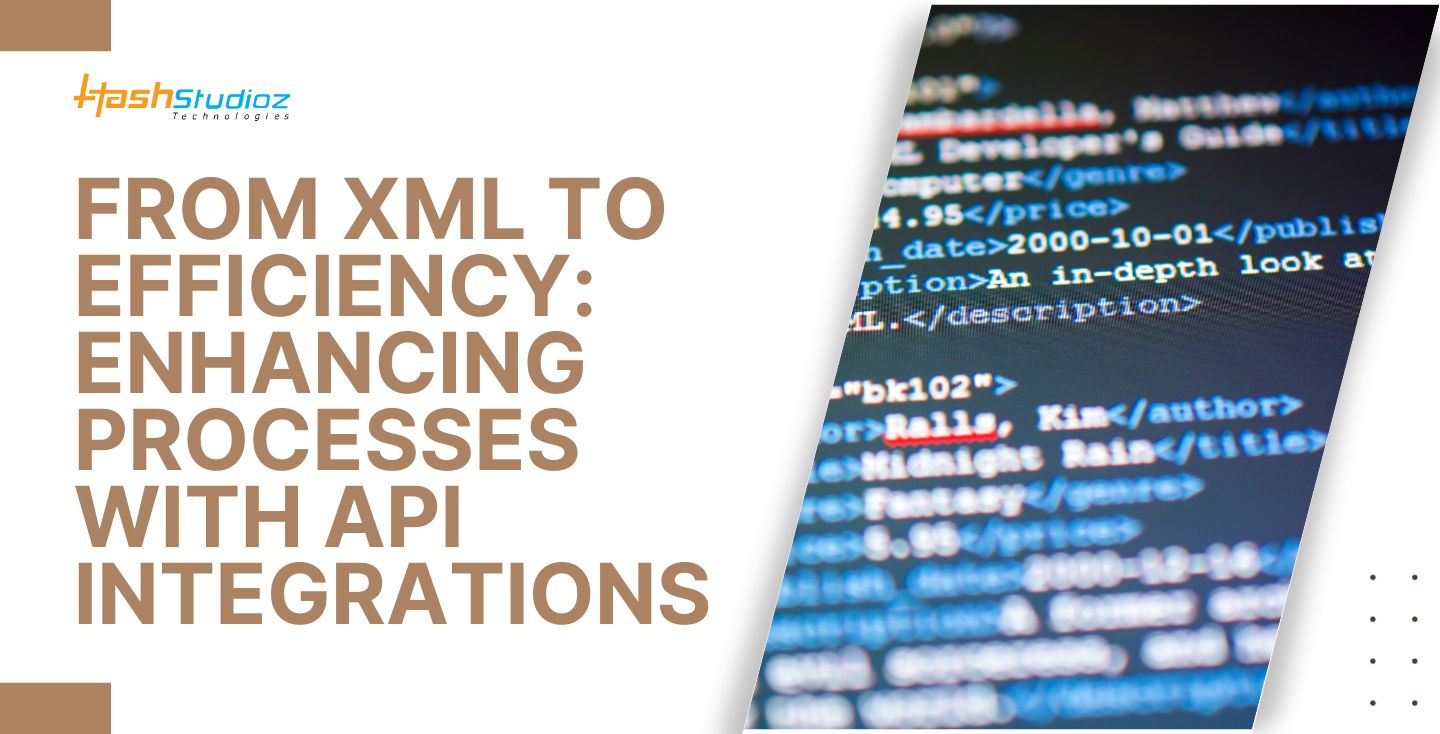From XML to Efficiency: Enhancing Processes with API Integrations

Businesses are always looking for methods to improve efficiency and streamline their operations in the quickly changing world of technology. Application Programming Interface (API) integrations are a crucial instrument in this optimization effort. This piece will examine the progression from XML, a popular data format, to the revolutionary potential of API interfaces and how companies may use this technology to enter a new era of productivity.
I. Understanding the Evolution: XML as a Data Format
A. XML Basics
XML, or eXtensible Markup Language, has been a cornerstone in data representation for decades. Its hierarchical structure allows for the organized storage and exchange of information between systems.
B. Benefits and Limitations of XML
- Benefits
- Human-Readable: XML is easily readable and writable by both humans and machines.
- Platform Independence: XML is platform-independent, making it an ideal choice for data exchange between heterogeneous systems.
- Limitations
- Verbosity: XML can be verbose, leading to larger file sizes and increased bandwidth usage.
- Complexity: Complex XML structures can be challenging to work with and may hinder performance.
II. The Rise of API Integrations: Catalyst for Efficiency
A. APIs Unveiled
- Defining APIs
- API, or Application Programming Interface, acts as a bridge between different software applications, allowing them to communicate and share data seamlessly.
- Types of APIs
- RESTful APIs: Representational State Transfer APIs are stateless, scalable, and widely used for web services.
- SOAP APIs: Simple Object Access Protocol APIs use XML as a format for message exchange.
- JSON-RPC and GraphQL: Alternatives to XML for data interchange.
B. Advantages of API Integrations
- Real-Time Communication
- APIs enable real-time communication between applications, reducing delays in data transfer.
- Efficiency in Data Transfer
- Unlike XML, APIs often use lightweight data formats like JSON, optimizing data transfer efficiency.
- Enhanced Security
- APIs often employ secure authentication methods, ensuring data integrity and confidentiality.
III. Making the Transition: XML to API Integration
A. Challenges in Transition
- Legacy Systems
- Many businesses still rely on legacy systems that communicate using XML. Migrating to API integrations may pose challenges.
- Data Mapping
- Mapping data from XML to API-compatible formats requires careful consideration of data structures.
B. Strategies for Seamless Transition
- Gradual Adoption
- Businesses can opt for a phased approach, gradually integrating APIs while ensuring compatibility with existing systems.
- Data Transformation Tools
- Utilizing data transformation tools can streamline the process of converting XML data into API-friendly formats.
IV. Industry Use Cases: Success Stories of API Integration
A. E-commerce Giants
- Order Processing
- APIs facilitate real-time order processing, reducing latency in updating inventory and order status.
- Payment Gateways
- Integration with payment APIs enables secure and seamless transactions.
B. Healthcare Sector
- Electronic Health Records (EHR)
- API integrations enhance interoperability, allowing healthcare systems to share patient data securely.
- Appointment Scheduling
- Real-time scheduling through APIs improves patient experience and optimizes resource utilization.
V. Best Practices for Effective API Integration
A. API Documentation and Versioning
- Comprehensive Documentation
- Well-documented APIs ensure smooth integration by providing clear guidelines and examples.
- Version Control
- Versioning safeguards against compatibility issues, allowing businesses to manage updates without disrupting existing integrations.
B. Security Measures
- Authentication Protocols
- Implementing robust authentication protocols, such as OAuth, ensures secure data exchange.
- Data Encryption
- Encrypting data during transmission adds an extra layer of security, protecting sensitive information.
C. Monitoring and Analytics
- Real-Time Monitoring
- Regular monitoring of API performance helps identify issues promptly, ensuring uninterrupted service.
- Data Analytics
- Analyzing API usage data can provide insights into user behavior, helping businesses optimize their services.
VI. Future Trends: The Continuous Evolution of API Integrations
A. AI and Machine Learning Integration
- Predictive Analytics
- APIs integrated with AI enable businesses to leverage predictive analytics for better decision-making.
- Automated Data Processing
- Machine learning algorithms integrated through APIs automate data processing, reducing manual intervention.
B. Blockchain Integration
- Enhanced Security
- Blockchain integration with APIs ensures transparent and secure transactions.
- Smart Contracts
- APIs enable the integration of smart contracts, automating and securing contractual agreements.
VII. Overcoming Challenges: Strategies for Smooth API Integration
A. Compatibility Testing
- Test Environments
- Establishing dedicated test environments for APIs ensures that integrations can be thoroughly tested without impacting live systems.
- Regression Testing
- Continuous regression testing guarantees that new updates or integrations do not introduce unforeseen issues.
B. Scalability Planning
- Future-Proofing
- Designing API integrations with scalability in mind allows businesses to adapt to growing data volumes and user demands.
- Load Balancing
- Implementing load balancing strategies ensures consistent performance, even during periods of high traffic.
VIII. Industry Standards and Compliance
A. Adherence to Standards
- RESTful Standards
- Following RESTful principles ensures consistency and interoperability across various applications.
- Compliance Regulations
- Industries like finance and healthcare have specific compliance requirements; adherence to these regulations is paramount.
B. Data Privacy and GDPR Compliance
- User Consent Mechanisms
- Implementing clear user consent mechanisms aligns API integrations with data privacy regulations, such as GDPR.
- Data Minimization
- Adhering to the principle of data minimization ensures that only necessary information is exchanged through APIs.
IX. Navigating the Path to Success
A. Netflix: Streaming Success through APIs
- Content Delivery
- Netflix’s API-driven approach ensures seamless content delivery to millions of users, personalized based on their viewing habits.
- Recommendation Algorithms
- API integrations power Netflix’s recommendation engine, providing users with tailored content suggestions.
B. Salesforce: Transforming CRM with APIs
- Integration Hub
- Salesforce’s Integration Hub leverages APIs to connect various systems, providing a unified view of customer data.
- Automation of Workflows
- API integrations enable the automation of repetitive tasks, improving overall efficiency in customer relationship management.
X. The Role of Developer Communities
A. Open Source Contributions
- Collaborative Development
- Developer communities contribute to open-source API projects, fostering collaboration and innovation in the field.
- Knowledge Sharing
- Forums, blogs, and conferences provide platforms for developers to share insights, best practices, and solutions.
B. Continuous Learning and Adaptation
- Rapid Technological Advances
- Developer communities play a vital role in keeping developers abreast of the latest API trends and technologies.
- Feedback Loops
- Continuous feedback loops within developer communities contribute to the refinement and improvement of API integrations.
XI. The Human Element: User Experience and Feedback
A. User-Centric Design
- User Interface (UI) Considerations
- API integrations should not only prioritize functionality but also offer a user-friendly interface for ease of use.
- Accessibility
- Ensuring that API integrations are accessible to users with diverse needs contributes to a positive overall experience.
B. Feedback Mechanisms
- User Surveys
- Regular surveys and feedback mechanisms help businesses understand user satisfaction and identify areas for improvement.
- Iterative Improvements
- Implementing iterative improvements based on user feedback ensures that API integrations evolve in alignment with user expectations.
XII. Looking Ahead: Emerging Technologies and Beyond
A. Edge Computing Integration
- Reduced Latency
- Integrating APIs with edge computing technology reduces latency, providing faster response times for critical applications.
- Decentralized Architecture
- API integrations with edge computing contribute to the development of decentralized and distributed systems.
B. Internet of Things (IoT) Connectivity
- Data from IoT Devices
- APIs play a crucial role in facilitating communication between IoT devices, enabling the seamless exchange of data.
- Scalability in IoT Ecosystems
- API integrations support the scalability of IoT ecosystems, allowing for the efficient management of connected devices.
Conclusion: The Ever-Expanding Horizon of API Integrations
In addition to representing a development in technology, the transition from XML to API connections represents a fundamental change in the way companies function and provide value. The possibilities are boundless when it comes to user-centric design, developer communities working together, and the ongoing improvements in API technology. Businesses that want to remain competitive, flexible, and inventive in the fast-paced digital age must embrace API integrations as they negotiate this terrain. It is not just a matter of preference. The potential of efficiency through API integration is boundless, contingent only on the creativity and resourcefulness of those desiring to embrace its possibilities. This era of efficiency is here to stay.







